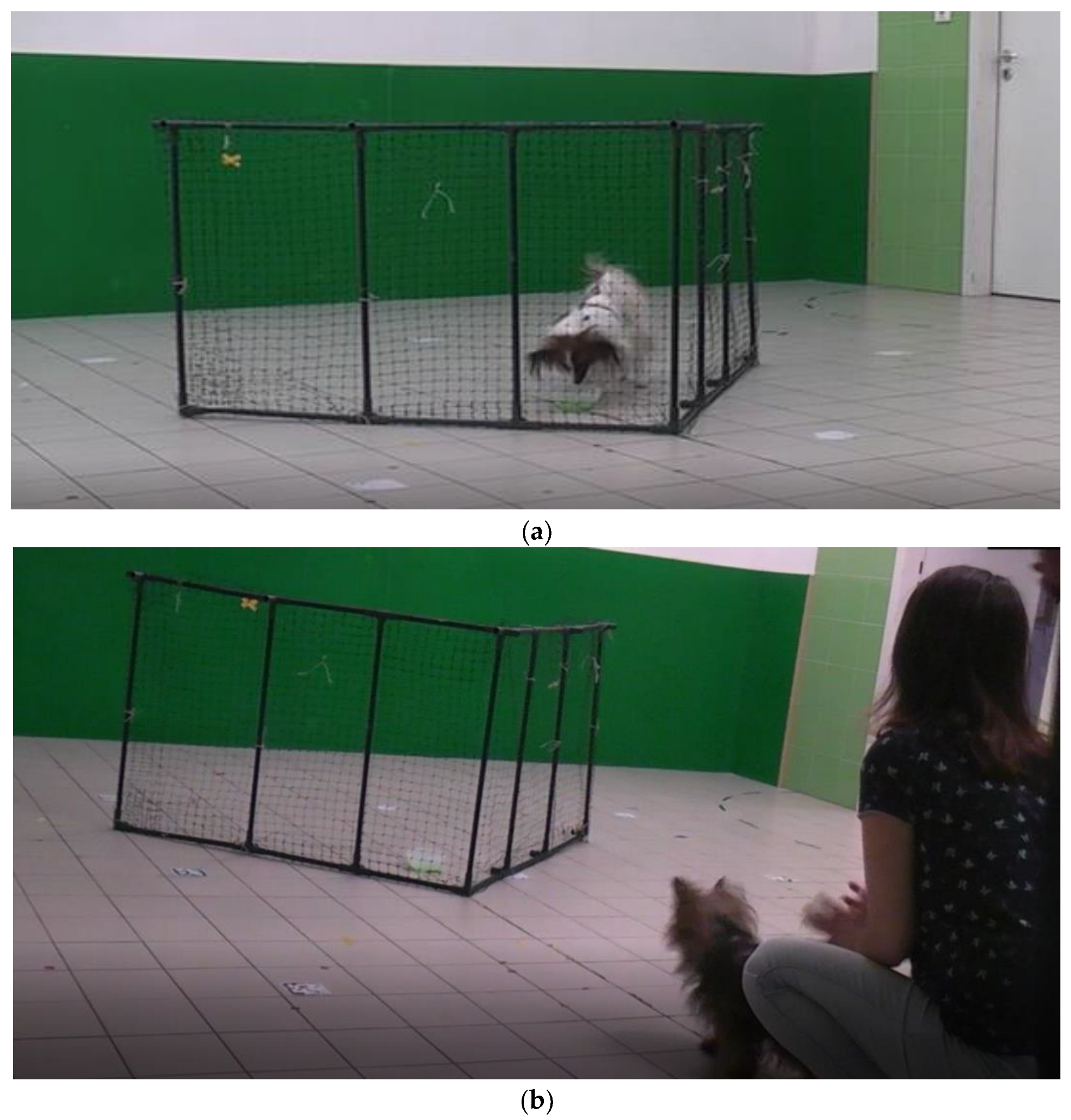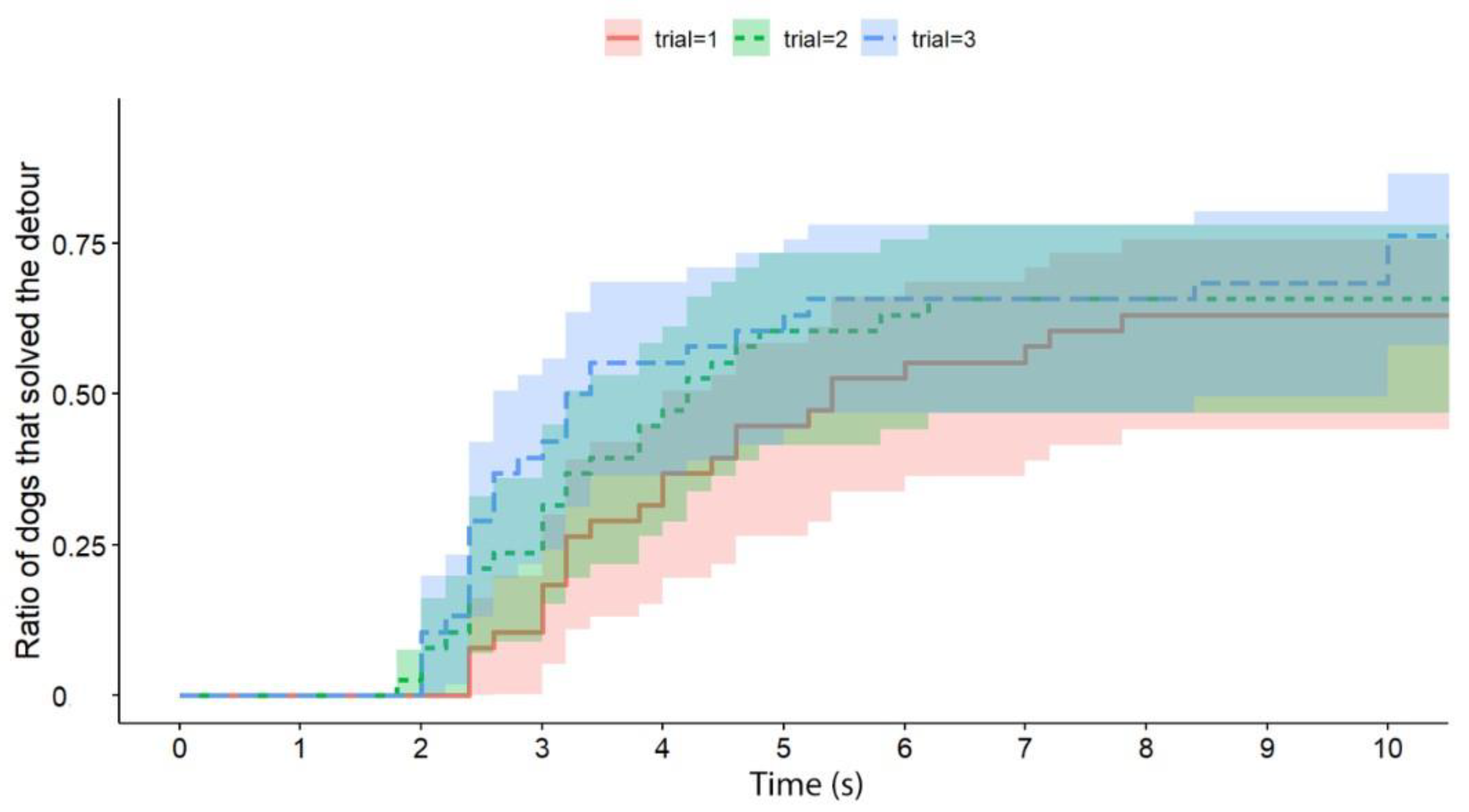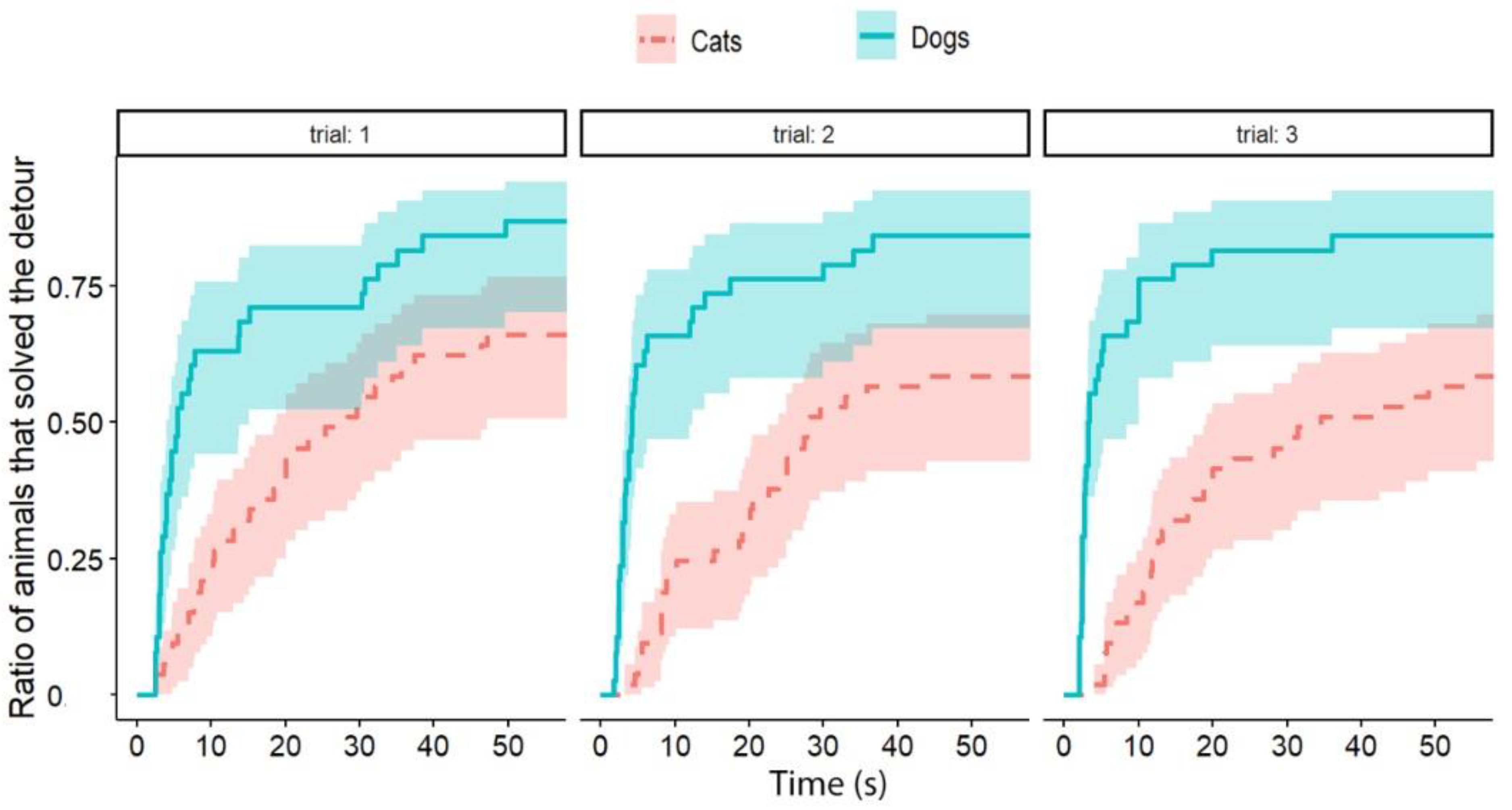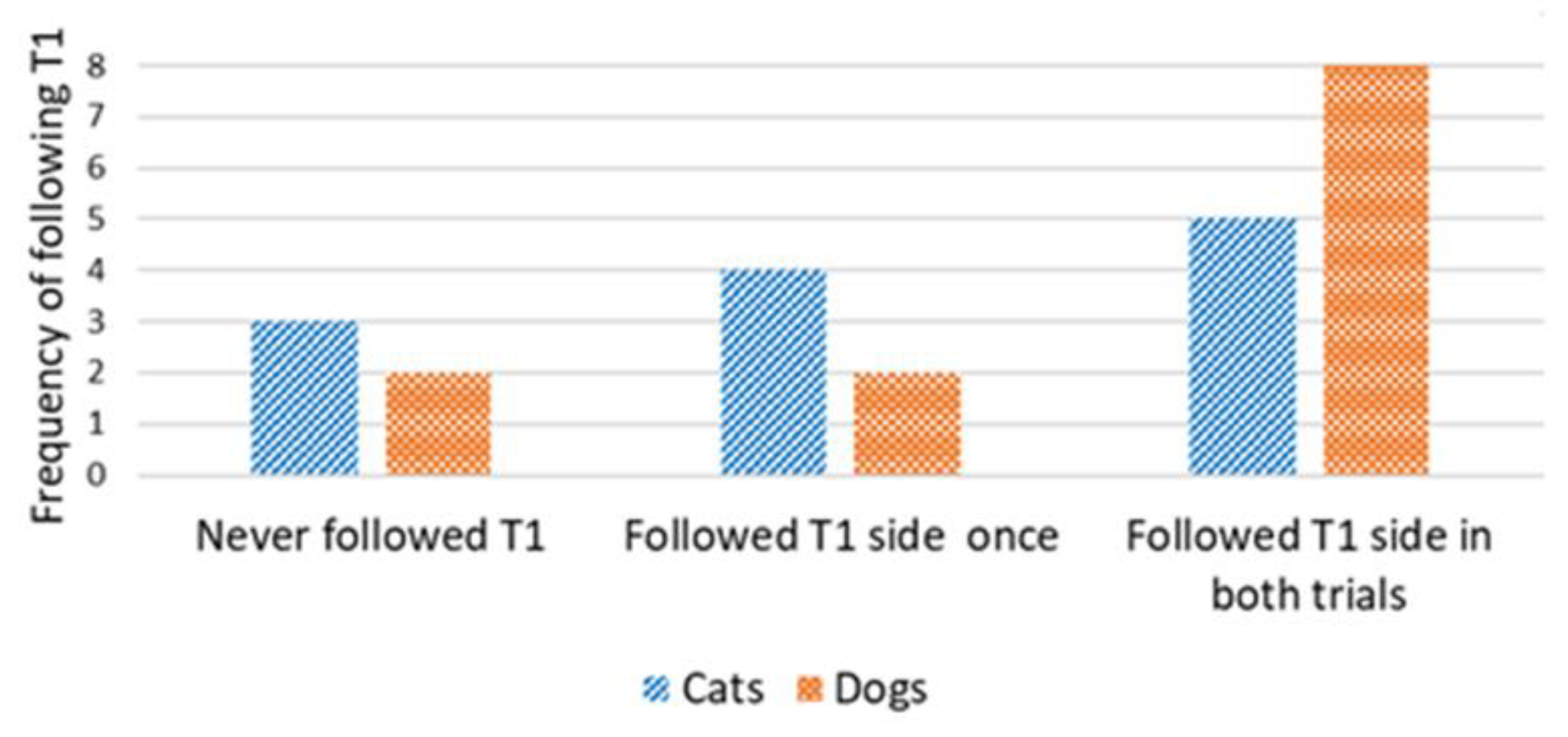Companion Cats Show No Effect of Trial-and-Error Learning Compared to Dogs in a Transparent-Obstacle Detour Task
Abstract
Simple Summary
Abstract
1. Introduction
2. Materials and Methods
2.1. Subjects
2.1.1. Companion Cats
2.1.2. Companion Dogs
2.2. Exclusions
2.2.1. Companion Cats
2.2.2. Companion Dogs
2.3. Procedure
2.3.1. Control Group
2.3.2. Straight-Pointing Group
2.3.3. Detour-Pointing Group
2.4. Data Collection
2.5. Statistical Analysis
3. Results
4. Discussion
5. Conclusions
Author Contributions
Funding
Institutional Review Board Statement
Informed Consent Statement
Data Availability Statement
Acknowledgments
Conflicts of Interest
References
- Kabadayi, C.; Bobrowicz, K.; Osvath, M. The detour paradigm in animal cognition. Anim. Cogn. 2018, 21, 21–35. [Google Scholar] [CrossRef] [PubMed]
- Chapuis, N.; Thinus-Blanc, C.; Poucet, B. Dissociation of mechanisms involved in dogs’ oriented displacements. Q. J. Exp. Psychol. 1983, 35, 213–219. [Google Scholar] [CrossRef] [PubMed]
- Poucet, B.; Thinus-Blanc, C.; Chapuis, N. Route planning in cats, in relation to the visibility of the goal. Anim. Behav. 1983, 31, 549–599. [Google Scholar] [CrossRef]
- Regolin, L.; Vallortigara, G.; Zanforlin, M. Object and spatial representations in detour problems by chicks. Anim. Behav. 1995, 49, 195–199. [Google Scholar] [CrossRef]
- Köhler, W. The Mentality of Apes; Routledge: London, UK, 1925. [Google Scholar]
- Shaw, R.C. Testing cognition in the wild: Factors affecting performance and individual consistency in two measures of avian cognition. Behav. Process. 2017, 134, 31–36. [Google Scholar] [CrossRef]
- Diamond, A. Developmental Time Course in Human Infants and Infant Monkeys, and the Neural Bases of Inhibitory Control in Reaching. Ann. N.Y. Acad. Sci. 1990, 608, 637–676. [Google Scholar] [CrossRef]
- Lockman, J.J. The development of detour ability during infancy. Child Dev. 1984, 55, 482–491. [Google Scholar] [CrossRef]
- Santacà, M.; Busatta, M.; Lucon-Xiccato, T.; Bisazza, A. Sensory differences mediate species variation in detour task performance. Anim. Behav. 2019, 155, 153–162. [Google Scholar] [CrossRef]
- Clarke, R.S.; Heron, W.; Fetherstonhaugh, M.L.; Forgays, D.G.; Hebb, D.O. Individual differences in dogs: Preliminary report on the effects of early experience. Can. J. Psychol. 1951, 5, 150–156. [Google Scholar] [CrossRef]
- Nawroth, C.; Baciadonna, L.; McElligott, A.G. Goats learn socially from humans in a spatial problem-solving task. Anim. Behav. 2016, 121, 123–129. [Google Scholar] [CrossRef]
- Pongrácz, P.; Miklósi, Á.; Kubinyi, E.; Gurobi, K.; Topál, J.; Csányi, V. Social learning in dogs: The effect of a human demonstrator on the performance of dogs in a detour task. Anim. Behav. 2001, 62, 1109–1117. [Google Scholar] [CrossRef]
- Regolin, L.; Vallortigara, G.; Zanforlin, M. Perceptual and motivational aspects of detour behaviour in young chicks. Anim. Behav. 1994, 47, 123–131. [Google Scholar] [CrossRef]
- Lorenz, K. Betrachtungen über das Erkennen der Arteigenen Triebhandlungen der Vögel. J. Ornithol. 1932, 80, 50–98. [Google Scholar] [CrossRef]
- Tarsitano, M. Route selection by a jumping spider (Portia labiata) during the locomotory phase of a detour. Anim. Behav. 2006, 72, 1437–1442. [Google Scholar] [CrossRef]
- Cross, F.R.; Jackson, R.R. The execution of planned detours by spider-eating predators. J. Exp. Anal. Behav. 2016, 105, 194–210. [Google Scholar] [CrossRef]
- Zucca, P.; Antonelli, F.; Vallortigara, G. Detour behaviour in three species of birds: Quails (Coturnix sp.), herring gulls (Larus cachinnans) and canaries (Serinus canaria). Anim. Cogn. 2005, 8, 122–128. [Google Scholar] [CrossRef]
- Marshall-Pescini, S.; Virányi, Z.; Range, F. The effect of domestication on inhibitory control: Wolves and dogs compared. PLoS ONE 2015, 10, e0118469. [Google Scholar] [CrossRef]
- Smith, B.P.; Litchfield, C.A. How well do dingoes, Canis dingo, perform on the detour task? Anim. Behav. 2010, 80, 155–162. [Google Scholar] [CrossRef]
- Vlamings, P.H.J.M.; Hare, B.; Call, J. Reaching around barriers: The performance of the great apes and 3–5-year-old children. Anim. Cogn. 2010, 13, 273–285. [Google Scholar] [CrossRef][Green Version]
- Amici, F.; Aureli, F.; Call, J. Fission-Fusion Dynamics, Behavioral Flexibility and Inhibitory Control in Primates. Curr. Biol. 2008, 18, 1415–1419. [Google Scholar] [CrossRef]
- Burghardt, G. Learning processes in reptiles. In The Biology of the Reptilia: Volume 7—Ecology and Behavior; Gans, C., Tinkle, D.W., Eds.; Academic Press: Cambridge, MA, USA, 1977; pp. 555–681. [Google Scholar]
- Dettmer, A.M.; Murphy, A.M.; Suomi, S.J. Development of a cognitive testing apparatus for socially housed mother-peer-reared infant rhesus monkeys. Dev. Psychobiol. 2015, 57, 349–355. [Google Scholar] [CrossRef] [PubMed]
- Frank, H.; Frank, M.G. Comparison of problem-solving performance in six-week-old wolves and dogs. Anim. Behav. 1982, 30, 95–98. [Google Scholar] [CrossRef]
- Juszczak, G.R.; Miller, M. Detour behavior of mice trained with transparent, semitransparent and opaque barriers. PLoS ONE 2016, 11, e0162018. [Google Scholar] [CrossRef] [PubMed]
- Pongrácz, P.; Miklósi, Á.; Kubinyi, E.; Topal, J.; Csányi, V. Interaction between individual experience and social learning in dogs. Anim. Behav. 2003, 65, 595–603. [Google Scholar] [CrossRef]
- Pongrácz, P.; Miklósi, Á.; Timár-Geng, K.; Csányi, V. Preference for Copying Unambiguous Demonstrations in Dogs (Canis familiaris). J. Comp. Psychol. 2003, 117, 337–343. [Google Scholar] [CrossRef]
- Pongrácz, P.; Miklósi, A.; Timár-Geng, K.; Csányi, V. Verbal attention getting as a key factor in social learning between dog (Canis familiaris) and human. J. Comp. Psychol. 2004, 118, 375–383. [Google Scholar] [CrossRef]
- Pongrácz, P.; Vida, V.; Bánhegyi, P.; Miklósi, Á. How does dominance rank status affect individual and social learning performance in the dog (Canis familiaris)? Anim. Cogn. 2008, 11, 75–82. [Google Scholar] [CrossRef]
- Osthaus, B.; Marlow, D.; Ducat, P. Minding the gap: Spatial perseveration error in dogs. Anim. Cogn. 2010, 13, 881–885. [Google Scholar] [CrossRef]
- Bray, E.E.; MacLean, E.L.; Hare, B.A. Increasing arousal enhances inhibitory control in calm but not excitable dogs. Anim. Cogn. 2015, 18, 1317–1329. [Google Scholar] [CrossRef]
- Pyari, M.S.; Uccheddu, S.; Lenkei, R.; Pongrácz, P. Inexperienced but still interested—Indoor-only cats are more inclined for predatory play than cats with outdoor access. Appl. Anim. Behav. Sci. 2021, 241, 105373. [Google Scholar] [CrossRef]
- Baker, P.J.; Molony, S.E.; Stone, E.; Cuthill, I.C.; Harris, S. Cats about town: Is predation by free-ranging pet cats Felis catus likely to affect urban bird populations? Ibis 2008, 150, 86–99. [Google Scholar] [CrossRef]
- Seymour, C.L.; Simmons, R.E.; Morling, F.; George, S.T.; Peters, K.; O’Riain, M.J. Caught on camera: The impacts of urban domestic cats on wild prey in an African city and neighbouring protected areas. Glob. Ecol. Conserv. 2020, 23, e01198. [Google Scholar] [CrossRef]
- Doré, F.Y. Object permanence in adult cats (Felis catus). J. Comp. Psychol. 1986, 100, 340. [Google Scholar] [CrossRef]
- Goulet, S.; Doré, F.Y.; Rousseau, R. Object Permanence and Working Memory in Cats (Felis catus). J. Exp. Psychol. Anim. Behav. Process. 1994, 20, 347. [Google Scholar] [CrossRef]
- Thinus-Blanc, C.; Poucet, B.; Chapuis, N. Object permanence in cats: Analysis in locomotor space. Behav. Process. 1982, 7, 81–86. [Google Scholar] [CrossRef]
- Triana, E.; Pasnak, R. Object permanence in cats and dogs. Anim. Learn. Behav. 1981, 9, 135–139. [Google Scholar] [CrossRef]
- Doré, F.Y. Search behaviour of cats (Felis catus) in an invisible displacement test: Cognition and experience. Can. J. Psychol. 1990, 44, 359–370. [Google Scholar] [CrossRef]
- Dumas, C.; Doré, F.Y. Cognitive development in kittens (Felis catus): A cross-sectional study of object permanence. J. Comp. Psychol. 1989, 103, 191. [Google Scholar] [CrossRef]
- Pasnak, R.; Kurkjian, M.; Triana, E. Assessment of Stage 6 object permanence. Bull. Psychon. Soc. 1988, 26, 368–370. [Google Scholar] [CrossRef]
- Dumas, C. Object permanence in cats (Felis catus): An ecological approach to the study of invisible displacements. J. Comp. Psychol. 1992, 106, 404–410. [Google Scholar] [CrossRef]
- Sherman, B.L.; Gruen, M.E.; Meeker, R.B.; Milgram, B.; DiRivera, C.; Thomson, A.; Clary, G.; Hudson, L. The use of a T-maze to measure cognitive-motor function in cats (Felis catus). J. Vet. Behav. 2013, 8, 32–39. [Google Scholar] [CrossRef]
- Pongrácz, P. Social learning in dogs. In The Social Dog: Behavior and Cognition; Kaminski, J., Marshall-Pescini, S., Eds.; Academic Press: Cambridge, MA, USA, 2014; pp. 249–293. [Google Scholar]
- Miklósi, Á.; Pongrácz, P.; Lakatos, G.; Topál, J.; Csányi, V. A comparative study of the use of visual communicative signals in interactions between dogs (Canis familiaris) and humans and cats (Felis catus) and humans. J. Comp. Psychol. 2005, 119, 179. [Google Scholar] [CrossRef] [PubMed]
- Fleming, P.A.; Crawford, H.M.; Auckland, C.H.; Calver, M.C. Body size and bite force of stray and feral cats—Are bigger or older cats taking the largest or more difficult-to-handle prey? Animals 2020, 10, 707. [Google Scholar] [CrossRef] [PubMed]
- Ellis, S.L.H. Environmental enrichment. Practical strategies for improving feline welfare. J. Feline Med. Surg. 2009, 11, 901–912. [Google Scholar] [CrossRef] [PubMed]
- Lord, K. A Comparison of the Sensory Development of Wolves (Canis lupus lupus) and Dogs (Canis lupus familiaris). Ethology 2013, 119, 110–120. [Google Scholar] [CrossRef]
- Pongrácz, P.; Miklósi, Á.; Vida, V.; Csányi, V. The pet dogs ability for learning from a human demonstrator in a detour task is independent from the breed and age. Appl. Anim. Behav. Sci. 2005, 90, 309–323. [Google Scholar] [CrossRef]
- Lazarowski, L.; Krichbaum, S.; Waggoner, L.P.; Katz, J.S. The development of problem-solving abilities in a population of candidate detection dogs (Canis familiaris). Anim. Cogn. 2020, 23, 755–768. [Google Scholar] [CrossRef]
- Pongrácz, P.; Szapu, J.S.; Faragó, T. Cats (Felis silvestris catus) read human gaze for referential information. Intelligence 2019, 74, 43–52. [Google Scholar] [CrossRef]
- Saito, A.; Shinozuka, K.; Ito, Y.; Hasegawa, T. Domestic cats (Felis catus) discriminate their names from other words. Sci. Rep. 2019, 9, 5394. [Google Scholar] [CrossRef]
- Pongrácz, P.; Onofer, D.L. Cats show an unexpected pattern of response to human ostensive cues in a series of A-not-B error tests. Anim. Cogn. 2020, 23, 681–689. [Google Scholar] [CrossRef]
- Udell, M.A.R.; Dorey, N.R.; Wynne, C.D.L. Can your dog read your mind? Understanding the causes of canine perspective taking. Learn. Behav. 2011, 39, 289–302. [Google Scholar] [CrossRef] [PubMed]
- Hegedüs, D.; Bálint, A.; Miklósi, Á.; Pongrácz, P. Owners fail to influence the choices of dogs in a two-choice, visual pointing task. Behaviour 2013, 150, 427–443. [Google Scholar]
- Brucks, D.; Marshall-Pescini, S.; Wallis, L.J.; Huber, L.; Range, F. Measures of dogs’ inhibitory control abilities do not correlate across tasks. Front. Psychol. 2017, 8, 849. [Google Scholar] [CrossRef] [PubMed]
- Pongrácz, P.; Rieger, G.; Vékony, K. Grumpy dogs are smart learners—The association between dog-owner relationship and dogs’ performance in a social learning task. Animals 2021, 11, 961. [Google Scholar] [CrossRef]
- Jahn-Eimermacher, A.; Lasarzik, I.; Raber, J. Statistical analysis of latency outcomes in behavioral experiments. Behav. Brain Res. 2011, 221, 271–275. [Google Scholar] [CrossRef]
- Vitale Shreve, K.R.; Mehrkam, L.R.; Udell, M.A.R. Social interaction, food, scent or toys? A formal assessment of domestic pet and shelter cat (Felis silvestris catus) preferences. Behav. Process. 2017, 141, 322–328. [Google Scholar] [CrossRef]
- Fugazza, C.; Miklósi, Á. Measuring the behaviour of dogs: An ethological approach. In Domestic Dog Cognition and Behavior: The Scientific Study of Canis familiaris; Springer: Berlin/Heidelberg, Germany, 2014. [Google Scholar] [CrossRef]
- Edwards, G.P.; De Preu, N.; Crealy, I.V.; Shakeshaft, B.J. Habitat selection by feral cats and dingoes in a semi-arid woodland environment in central Australia. Austral Ecol. 2002, 27, 26–31. [Google Scholar] [CrossRef]
- Byrne, M.; Bray, E.; Maclean, E.; Johnston, A. Evidence for win-stay-lose-shift in puppies and adult dogs. In Proceedings of the 42nd Annual Meeting of the Cognitive Sciences Society, Virtual Meeting, 29 July–1 August 2020; pp. 2884–2889. [Google Scholar]
- Vitale, K.R.; Behnke, A.C.; Udell, M.A.R. Attachment bonds between domestic cats and humans. Curr. Biol. 2019, 29, R864–R865. [Google Scholar] [CrossRef]
- Topál, J.; Miklósi, Á.; Csányi, V. Dog-human relationship affects problem solving behavior in the dog. Anthrozoös 1997, 10, 214–224. [Google Scholar] [CrossRef]
- Udell, M.A.R.; Dorey, N.R.; Wynne, C.D.L. Wolves outperform dogs in following human social cues. Anim. Behav. 2008, 76, 1767–1773. [Google Scholar] [CrossRef]
- Hyman, I. It’s Alive! Why Cats Love Laser Pointers. 2011. Available online: https://www.psychologytoday.com/us/blog/mental-mishaps/201101/its-alive-why-cats-love-laser-pointers (accessed on 18 March 2022).
- Kogan, L.R.; Grigg, E.K. Laser light pointers for use in companion cat play: Association with guardian-reported abnormal repetitive behaviors. Animals 2021, 11, 2178. [Google Scholar] [CrossRef] [PubMed]






| Behavior | Description |
|---|---|
| Reach food/‘success’ (frequency) | After performing the detour, the subject comes in contact with the food (eats/sniffs it). |
| Latency of detour | The time elapsed from subject release (by the owner) until the subject reached the food. In the case of unsuccessful trials, the maximum value of 60 s is recorded as latency. |
| Direction of detour (frequency) | The side (right/left) of the V-shaped fence chosen by the subject, eventually leading to reward success. |
| Looking back (frequency) | The subject turns back (entirely or just with their head) towards the owner, while attempting to detour the fence. This behavior was coded from the release of the subject only until they reached the far end of the fence and turned towards the reward, as from this point on, the subject was facing towards the owner. |
Disclaimer/Publisher’s Note: The statements, opinions and data contained in all publications are solely those of the individual author(s) and contributor(s) and not of MDPI and/or the editor(s). MDPI and/or the editor(s) disclaim responsibility for any injury to people or property resulting from any ideas, methods, instructions or products referred to in the content. |
© 2022 by the authors. Licensee MDPI, Basel, Switzerland. This article is an open access article distributed under the terms and conditions of the Creative Commons Attribution (CC BY) license (https://creativecommons.org/licenses/by/4.0/).
Share and Cite
Shajid Pyari, M.; Vékony, K.; Uccheddu, S.; Pongrácz, P. Companion Cats Show No Effect of Trial-and-Error Learning Compared to Dogs in a Transparent-Obstacle Detour Task. Animals 2023, 13, 32. https://doi.org/10.3390/ani13010032
Shajid Pyari M, Vékony K, Uccheddu S, Pongrácz P. Companion Cats Show No Effect of Trial-and-Error Learning Compared to Dogs in a Transparent-Obstacle Detour Task. Animals. 2023; 13(1):32. https://doi.org/10.3390/ani13010032
Chicago/Turabian StyleShajid Pyari, Muhzina, Kata Vékony, Stefania Uccheddu, and Péter Pongrácz. 2023. "Companion Cats Show No Effect of Trial-and-Error Learning Compared to Dogs in a Transparent-Obstacle Detour Task" Animals 13, no. 1: 32. https://doi.org/10.3390/ani13010032
APA StyleShajid Pyari, M., Vékony, K., Uccheddu, S., & Pongrácz, P. (2023). Companion Cats Show No Effect of Trial-and-Error Learning Compared to Dogs in a Transparent-Obstacle Detour Task. Animals, 13(1), 32. https://doi.org/10.3390/ani13010032






